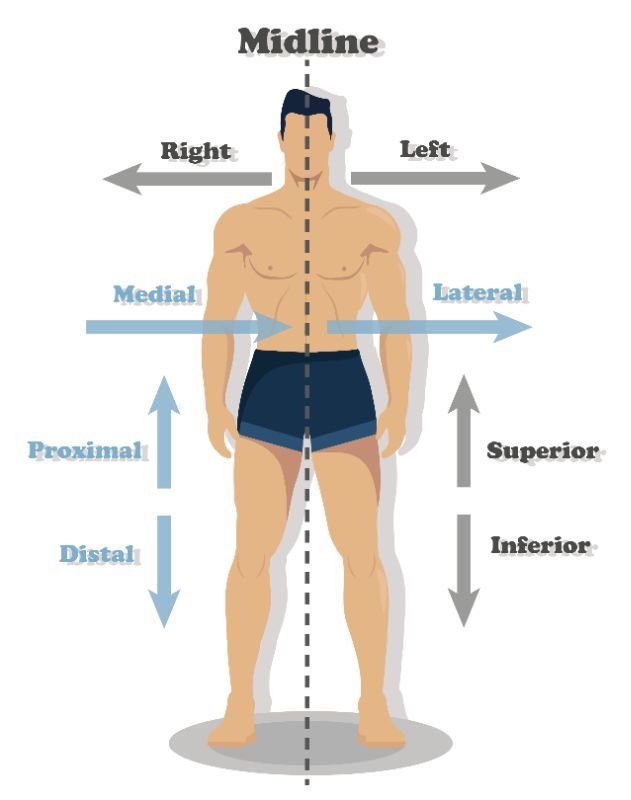Ch. 1 The Human Body: An Orientation
 Back
Back- The correct sequence of levels forming the structural hierarchy is: a. organ, organ system, cellular, chemical, tissue, organismal b. chemical, cellular, tissue, organismal, organ, organ system c. chemical, cellular, tissue, organ, organ system, organismal d. organismal, organ system, organ, tissue, cellular, chemical
Problem 1
- The structural and functional unit of life is a. a cell, b. an organ, c. the organism, d. a molecule.
Problem 2
- Which of the following is a major functional characteristic of all organisms? a. movement, b. growth, c. metabolism, d. responsiveness, e. all of these.
Problem 3
- Two of these organ systems bear the major responsibility for ensuring homeostasis of the internal environment. Which two? a. nervous system, b. digestive system, c. cardiovascular system, d. endocrine system, e. reproductive system.
Problem 4
- In (a)–(e), a directional term [e.g., distal in (a)] is followed by terms indicating different body structures or locations (e.g., the elbow/the wrist). In each case, choose the structure or organ that matches the given directional term. a. distal: the elbow/the wrist, b. lateral: the hip bone/the umbilicus, c. superior: the nose/the chin, d. anterior: the toes/the heel, e. superficial: the scalp/the skull
Problem 5
- Which ventral cavity subdivision has no bony protection? a. thoracic cavity, b. abdominal cavity, c. pelvic cavity.
Problem 6
- Terms that apply to the backside of the body in the anatomical position include: a. ventral; anterior, b. back; rear, c. posterior; dorsal, d. medial; lateral
Problem 7
- According to the principle of complementarity, how does anatomy relate to physiology?
Problem 8
- Construct a table that lists the 11 systems of the body, names two organs of each system (if appropriate), and describes the overall or major function of each system.
Problem 9
- Describe the location and position of the heart in the body.
Problem 9
- List and describe briefly five external factors that must be present or provided to sustain life.
Problem 10
- Define homeostasis.
Problem 11
- Define plane and section.
Problem 12
Problem 13
Provide the anatomical term that correctly names each of the following body regions: a. arm, b. thigh, c. chest, d. fingers and toes, e. anterior aspect of the knee.
- a. Make a diagram showing the nine abdominopelvic regions, and name each region. Name two organs (or parts of organs) that could be located in each of the named regions. b. Make a similar sketch illustrating how the abdominopelvic cavity may be divided into quadrants, and name each quadrant.
Problem 14
- Assume that the body has been sectioned along three planes: (1) a median plane, (2) a frontal plane, and (3) a transverse plane made at the level of each of the organs listed below. Which organs would be visible in only one or two of these three cases? a. urinary bladder, b. brain, c. lungs, d. kidneys, e. small intestine, f. heart.
Problem 15
- Relate each of the following conditions or statements to either the dorsal body cavity or the ventral body cavity. a. surrounded by the bony skull and the vertebral column b. includes the thoracic and abdominopelvic cavities c. contains the brain and spinal cord d. contains the heart, lungs, and digestive organs
Problem 16
- Which of the following relationships is incorrect? a. visceral peritoneum/outer surface of small intestine b. parietal pericardium/outer surface of heart c. parietal pleura/wall of thoracic cavity
Problem 17
- Compare and contrast the operation of negative and positive feedback mechanisms in maintaining homeostasis. Provide two examples of variables controlled by negative feedback mechanisms and one example of a process regulated by a positive feedback mechanism.
Problem 18
- Why is an understanding of the anatomical position important?
Problem 19
- Use as many directional terms as you can to describe the relationship between the elbow's olecranal region and your palm.
Problem 20
- At the clinic, Harry was told that blood would be drawn from his antecubital region. What body part was Harry asked to hold out? Later, the nurse came in and gave Harry a shot of penicillin in the area just distal to his acromial region. Did Harry take off his shirt or drop his pants to receive the injection? Before Harry left, the nurse noticed that Harry had a nasty bruise on his gluteal region. What part of his body was black and blue?
Problem 21
- Calcium levels in Mr. Gallariani's blood are dropping to dangerously low levels. The hormone PTH is released and soon blood calcium levels begin to rise. Shortly after, PTH release slows. Is this an example of a positive or negative feedback mechanism? What is the initial stimulus? What is the result?
Problem 22
- Aiden has been suffering agonizing pain with each breath and has been informed by the physician that he has pleurisy. a. Specifically, what membranes are involved in this condition? b. What is their usual role in the body? c. Explain why Aiden's condition is so painful.
Problem 24


